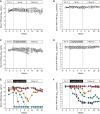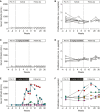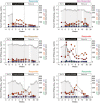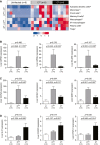Toll-Like Receptor 8 Agonist GS-9688 Induces Sustained Efficacy in the Woodchuck Model of Chronic Hepatitis B
- PMID: 32246499
- PMCID: PMC7898792
- DOI: 10.1002/hep.31255
Toll-Like Receptor 8 Agonist GS-9688 Induces Sustained Efficacy in the Woodchuck Model of Chronic Hepatitis B
Abstract
Background and aims: GS-9688 (selgantolimod) is an oral selective small molecule agonist of toll-like receptor 8 in clinical development for the treatment of chronic hepatitis B. In this study, we evaluated the antiviral efficacy of GS-9688 in woodchucks chronically infected with woodchuck hepatitis virus (WHV), a hepadnavirus closely related to hepatitis B virus.
Approach and results: WHV-infected woodchucks received eight weekly oral doses of vehicle, 1 mg/kg GS-9688, or 3 mg/kg GS-9688. Vehicle and 1 mg/kg GS-9688 had no antiviral effect, whereas 3 mg/kg GS-9688 induced a >5 log10 reduction in serum viral load and reduced WHV surface antigen (WHsAg) levels to below the limit of detection in half of the treated woodchucks. In these animals, the antiviral response was maintained until the end of the study (>5 months after the end of treatment). GS-9688 treatment reduced intrahepatic WHV RNA and DNA levels by >95% in animals in which the antiviral response was sustained after treatment cessation, and these woodchucks also developed detectable anti-WHsAg antibodies. The antiviral efficacy of weekly oral dosing with 3 mg/kg GS-9688 was confirmed in a second woodchuck study. The antiviral response to GS-9688 did not correlate with systemic GS-9688 or cytokine levels but was associated with transient elevation of liver injury biomarkers and enhanced proliferative response of peripheral blood mononuclear cells to WHV peptides. Transcriptomic analysis of liver biopsies taken prior to treatment suggested that T follicular helper cells and various other immune cell subsets may play a role in the antiviral response to GS-9688.
Conclusions: Finite, short-duration treatment with a clinically relevant dose of GS-9688 is well tolerated and can induce a sustained antiviral response in WHV-infected woodchucks; the identification of a baseline intrahepatic transcriptional signature associated with response to GS-9688 treatment provides insights into the immune mechanisms that mediate this antiviral effect.
© 2020 The Authors. Hepatology published by Wiley Periodicals LLC on behalf of American Association for the Study of Liver Diseases.
Figures







References
-
- Bertoletti A, Ferrari C. Adaptive immunity in HBV infection. J Hepatol 2016;64(1 Suppl.):S71‐S83. - PubMed
-
- Maini MK, Burton AR. Restoring, releasing or replacing adaptive immunity in chronic hepatitis B. Nat Rev Gastroenterol Hepatol 2019;16:662‐675. - PubMed
-
- Gorden KB, Gorski KS, Gibson SJ, Kedl RM, Kieper WC, Qiu X, et al. Synthetic TLR agonists reveal functional differences between human TLR7 and TLR8. J Immunol 2005;174:1259‐1268. - PubMed
-
- Peng G, Guo Z, Kiniwa Y, Voo KS, Peng W, Fu T, et al. Toll‐like receptor 8‐mediated reversal of CD4+ regulatory T cell function. Science 2005;309:1380‐1384. - PubMed
Publication types
MeSH terms
Substances
LinkOut - more resources
Full Text Sources

